Waters Introduces Its Most Advanced Ion Mobility-Enhanced Research Mass Spectrometer, the SYNAPT G2-Si, at ASMS 2013
10 Jun 2013Waters Corporation today unveiled the new Waters SYNAPT G2-Si Mass Spectrometer at the 61st conference of the American Society of Mass Spectrometry (ASMS). The company is also previewing its UNIFI CCS Research Edition and the new TransOmics Version 2.0 informatics products for the new SYNAPT G2-Si mass spectrometer and demonstrating their benefits for a variety of small molecule applications and cutting-edge Omics-focused research.
The SYNAPT G2-Si System integrates a third dimension of resolution and separation power into a new suite of untargeted and targeted LC/MS/MS workflows. This powerful new tool gives researchers a means with which to gain a deeper understanding of molecular biology and disease mechanisms, to develop the next generation of healthcare treatments or chemical materials, or to screen food products or environmental samples for contaminants. The SYNAPT G2-Si mass spectrometer now combines the unique power of Travelling Wave (T-Wave) Ion Mobility Separations with new data acquisition and informatics technologies, and collision cross section (CCS) measurements to bring to the toughest analytical applications, unparalleled information and confidence at a level not possible by mass and chromatographic separation alone.
The SYNAPT G2-Si mass spectrometer is the first MS system to elevate CCS alongside retention time and mass to charge ratio (m/z) as a robust, reliable identification parameter in library-based screening. “CCS measurements have the potential to transform the way people screen for known compounds, because unlike parameters like retention time, CCS values are unaffected by different matrices and chromatographic methods, and give you a much higher level of confidence that you found what you’re looking for” said Dr. Severine Goscinny, Belgium Scientific Institute for Public Health, Brussels, Belgium. The SYNAPT G2-Si system exemplifies Waters continuing commitment to innovation in mass spectrometry and collaborating with researchers on their journey of exploration.
The collision cross section of a molecule is an important distinguishing feature that is directly related to its chemical structure and three-dimensional conformation in the gas-phase. Like molecular mass, this additional orthogonal property of a molecule (through the use of high-efficiency T-wave ion mobility technology) gives scientists increased coverage and clarity for profiling mixtures or gaining additional measurements with which they can investigate chemical structures or better confirm a molecule s identity.
Integrating separation by CCS into targeted and untargeted experiments through new high-definition data-directed-analysis (HD-DDA) and high definition multiple reaction monitoring (HD-MRM) modes brings compelling benefits to the most challenging qualitative and quantitative applications.
As evidence of the successful use of T-Wave ion mobility mass spectrometry for the research laboratory, the International Journal of Ion Mobility Spectrometry in February of this year published an exclusive, two-volume special edition series on T-Wave ion mobility featuring 13 scientific articles by some of the world s top scientists.
As the newest member of the SYNAPT family of mass spectrometers, the SYNAPT G2-Si system can separate individual isomers, conformers, and isobaric compounds; help determine sites of biotransformation; study structure at physiological concentrations; comprehensively profile complex mixtures and minimize false positives and negatives in screening experiments.

